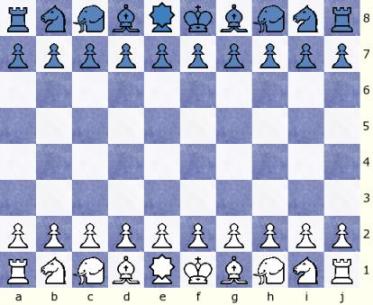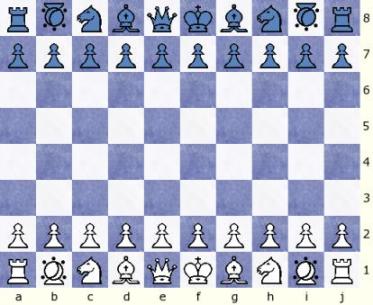Mini Courier Chess Moderno
Mini Courier Chess Moderno is a collection of proposed 10x8 "evolutional" variations of Courier Chess (12x8).
This is the first Mini Courier Chess Moderno setup. It has an Orthodox chess piece arrangement with Elephants between Bishops and Knights in a 10x8 board, with a Man or Commoner (instead of a Queen) next to the King just as in Courier Chess. This setup is the one that resembles it's Courier Chess ancestor the most. I consider this setup the first evolutionary step from Courier Chess towards our Orthodox Chess
I discovered 12x8 Courier Chess (diagram below left) in 2008. I found it to be an interesting "old" game, yet a bit clumsy and slow. So I started thinking of ways to improve it. Courier Chess Moderno (diagram below right) was the result of my experimentation with the original variant.
 ....
....
My new invention has more modern pawn move rules, castling, reverse symmetry and a (kind of) new piece: the Courier Elephant. I had no use for the very weak Courier Chess Alfil in my new improved Courier game, so I replaced it! My new elephant is a much better alternative for the game.
When I read H.G. Muller's very interesting theory adding Courier Chess as a possible direct ancestor of Orthodox Chess, it made me think of other possible "evolutional" alternatives to Courier Chess.
Basically Muller's theory is that if you dropped the four weakest pieces (Alfils, Schleich and the weak old little Queen [Ferz]), and promoted the Man or Commoner (who was already in the correct side of the King [from an Orthodox Chess perspective]) into the modern day Queen, you could go from the 12x8 Courier board down to our Orthodox 8x8 board and game almost in a single step!
Very interesting theory! I'm a firm believer that Muller is not very far off the actual truth!
But what if, instead of going straight from a 12x8 Courier board to our Orthodox one, the game had first evolved into a smaller 10x8 variation. What could it have looked like?
Instead of dropping the four weakest pieces as Muller recommended, we could just drop two of the weaker pieces (with their corresponding pawns) and keep or reinforce the other two.
Using my new stronger Courier Elephants instead of the old Alfils, would leave the Schleich and the old Queen (Ferz) as the weakest pieces, which would therefore be the two weak pieces to be removed...
Setup
 ............
............Removing the g & h-columns with the old Queen (Ferz) and the Schleich from an old Courier Chess 12x8 board (diagram above left), shrinking the board to 10x8 (above right) gives the Mini Courier Chess Moderno setup on the left below.

The Elephant between the Bishops and the Knights is the new Courier Elephant from Courier Chess Moderno (not the old Alfil from Courier Chess).
Pieces
All regular chess pieces (except for the elephants) in Mini Courrier Chess Moderno move as in Orthodox Chess. Pawns can play one or two squares in their initial move.The Courier Elephant is like a Burmese Elephant (one step diagonal in any direction, or one step forward) that also has the ability to leap 2-squares in ANY direction, on their very first move.
Essencially Courier Elephants have the priviledge of a single Shatranj Elephant (Alfil) 2-step diagonal leap for their first move, or a 2-step straight forward Dabbabah leap.
Courier Elephants are sort of "Burmese Elephant Pawns", they have the option of making an initial one or two-step forward (or diagonal) move (or leap).
The sample 12x8 Courrier board above shows how (on their first move) Courier Elephants can play 1-step diagonally foward or straight forward; or they can leap [square being jumped can be vacant or occupied] 2-steps diagonally forward or straight forward. See the elephants on j8 and c1 (represented by a white Silver General) above. Once they have first moved (or leaped), elephants can only move like Burmese Elephants or Silver Generals (i.e. elephants on j3 & e6 above that already leaped on their first move). Courier elephants can perform a capture with their initial leap.
Courier Elephants can reach all squares on the board and engage enemy elephants in battle (something not possible with the Elephant [Alfil] in Courrier Chess), as well as develop right from their first move. They are very nice and useful short-range attacking pieces, that are similar in value to the long-range color-bound Bishops and the leaping Knights. They can also be kept as short-rage defending pieces around the King.
The Man (or Commoner) moves one square in any arbitrary direction, just like the king (above), but is non-royal (not hindered by check).
Rules
The goal of the game is to checkmate the opponent's King, as in Orthodox Chess.Rules for en passant, check, checkmate, stalemate, 50-move draw and Threefold Repetition Draw are like in Orthodox Chess.
The "Bare King" condition (also found in Shatranj) applies. It occurs when a player has taken his opponent's last piece or pawn (i.e. only the opponent's King remains). This is a win for the first player unless the opponent's lonely King can then take the first player's last remaining piece or pawn on his next move (bearing the first player's King as well, i.e. King vs King), which is then a draw.
Pawns may promote to any piece (Man, Rook, Elephant, Bishop or Knight) upon reaching their last rank.
Castling is done by moving the King 3-steps in the direction of the Rook.
This table shows where the King and Rook end up and the notation for each type of castling.
| White castles short | O-O | Ki1, Rh1 |
|---|---|---|
| White castles long | O-O-O | Kc1, Rd1 |
| Black castles short | O-O | Ki8, Rh8 |
| Black castles long | O-O-O | Kc8, Rd8 |
Castling may only occur under the following conditions:
- Unmoved: The King and the castling Rook must not have moved before in the game, including a previous castling.
- Un-attacked: All of the squares between the king's initial and final squares (including the initial and final squares) must not be under attack by any opposing piece.
- Vacant: All the squares between the king's initial and final squares (including the final square), and all of the squares between the rook's initial and final squares (including the final square), must be vacant except for the king and castling rook.
- Castling cannot capture any pieces.
- The king and castling rook cannot "jump" over any pieces other than each other.
- A player may castle at most once in a game.
- If a player moves his king or both of his initial rooks without castling, he may not castle during the rest of the game.
- The king may not be in check before or after castling.
- The king cannot move through check.
Next Courier Chess "Evolutionary" Steps
Orthodox Queen Variant
 ....
....
Replacing the Man (Commoner) on the e-column with an Orthodox Queen, as H.G. Muller suggested, would complete the next "alternative" 10x8 evolution of Courier Chess (diagram above right).
In fact this variation may have been the direct predecesor for Orthodox Chess. Removing the columns with the weaker Elephants now would have transformed the game into our modern day chess:

Gifford Setup
My friend Gary Gifford, who helped me test try the Orthodox Queen setup, preferred the alternate setup below left; with the Courier Elephants starting between the Knights and the Rooks. This alternate setup is named after him. On the right below is the same Gifford setup but with Japanese Silver Generals (instead of Elephants) for those who would rather use that symbol for the Courier Elephant (like Gary!) .....
.....
Middlegames after 10-20 moves (including Courier Elephant moves), starting with either the Main or the Gifford setups look virtually identical.
Notes

The Orthodox Queen variation further inspired me to test another option.
Strengthening the Man to a powerful Orthodox Queen, relegated the Courier Elephant to a weaker short range (perhaps defensive) role. By strenghtening the Courier Elephants a step further: allowing them to leap 2 squares, and a new interesting variant was born: Silver Elephant Chess. Check it out!
Game Courier Presets
Man (Commoner) Setup
-> Main Setup: Man & Elephants (or Silver Generals)Orthodox Queen Variants
-> Main Setup: Queen & Elephants (or Silver Generals)-> Gifford's Setup: Queen & Elephants (or Silver Generals)
Game Courier Logs
Game Courier Logs for Games of Mini Courier Chess ModernoTo see actual games that have been played on-line, follow the link above.
Mini Courier Chess Moderno was proposed by Jose Manuel Carrillo-Muniz, from Puerto Rico in 2009.
Acknowledgements
I want to thank my good friend Gary Gifford for testing this variant with me. Additionally the 2nd setup (Elephant between Knight and Rook) is named after him.Chess Variants by the Author:
- Modern Random Chess (9x9)
- Contemporary Random Chess (8x8)
- Prime Ministers Chess (9x8)
- Modern Capablanca Random Chess (10x8)
- Modern English Random Chess (10x10)
- Pseudo-Modern Random Chess (9x9)
- Chess8400 (9x9)
- Prime Ministers Contemporary Random Chess (8x8)
- Prime Ministers Random Chess (9x8)
- International Contemporary Random Chess (10x10)
- International Fischer Random Chess (10x10)
- Courier Chess Moderno (12x8)
- Mini Courier Chess Moderno (10x8)
- Silver Elephant Chess (10x8)
- Modern Ministers Courier Chess (11x8)
- Ajax Chess (10x10)
- Partnership Chaturanga (8x8)
Other Pages by the Author:
- How to Generate Random Positions
- The Bishop Adjustment Rule
- The Modern Principles
- Reverse Symmetry
- The Prime Minister
- The Courier Elephant
- The 10x8 Variants
- Modern Chess Preset
- Makruk (Thai Chess) Preset
 This 'user submitted' page is a collaboration between the posting user and the Chess Variant Pages. Registered contributors to the Chess Variant Pages have the ability to post their own works, subject to review and editing by the Chess Variant Pages Editorial Staff.
This 'user submitted' page is a collaboration between the posting user and the Chess Variant Pages. Registered contributors to the Chess Variant Pages have the ability to post their own works, subject to review and editing by the Chess Variant Pages Editorial Staff.
By Jose Carrillo.
Web page created: 2009-06-06. Web page last updated: 2009-07-04
